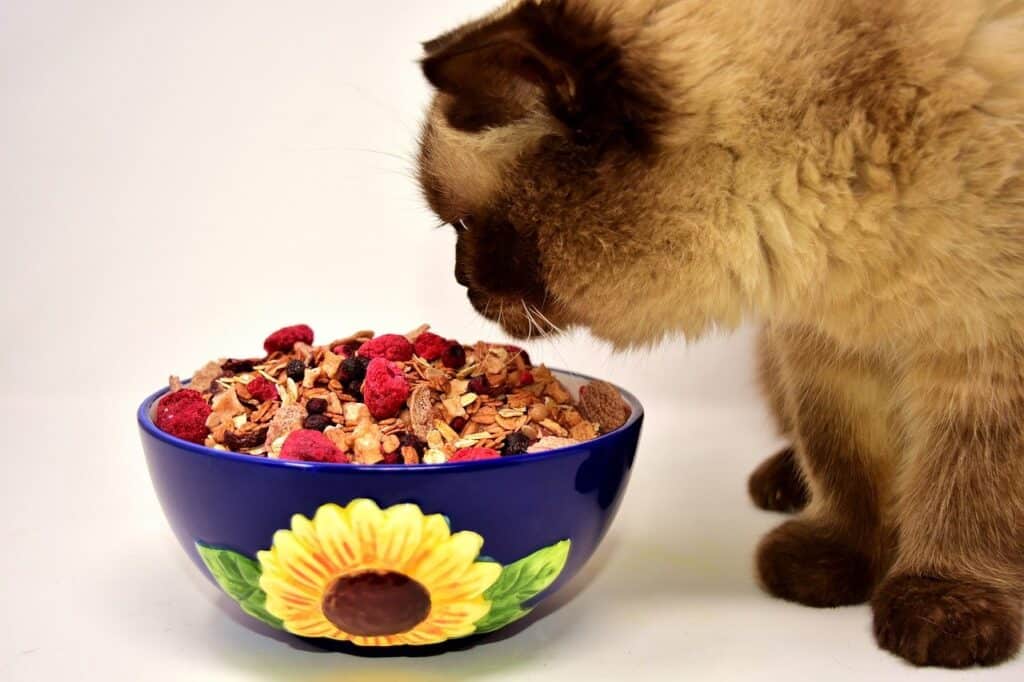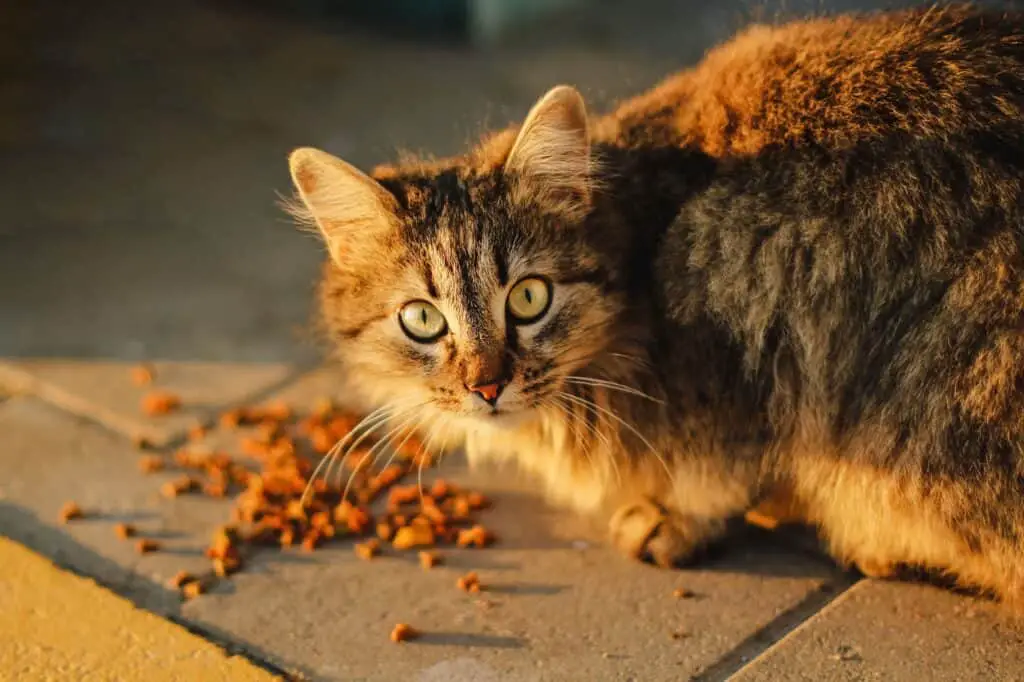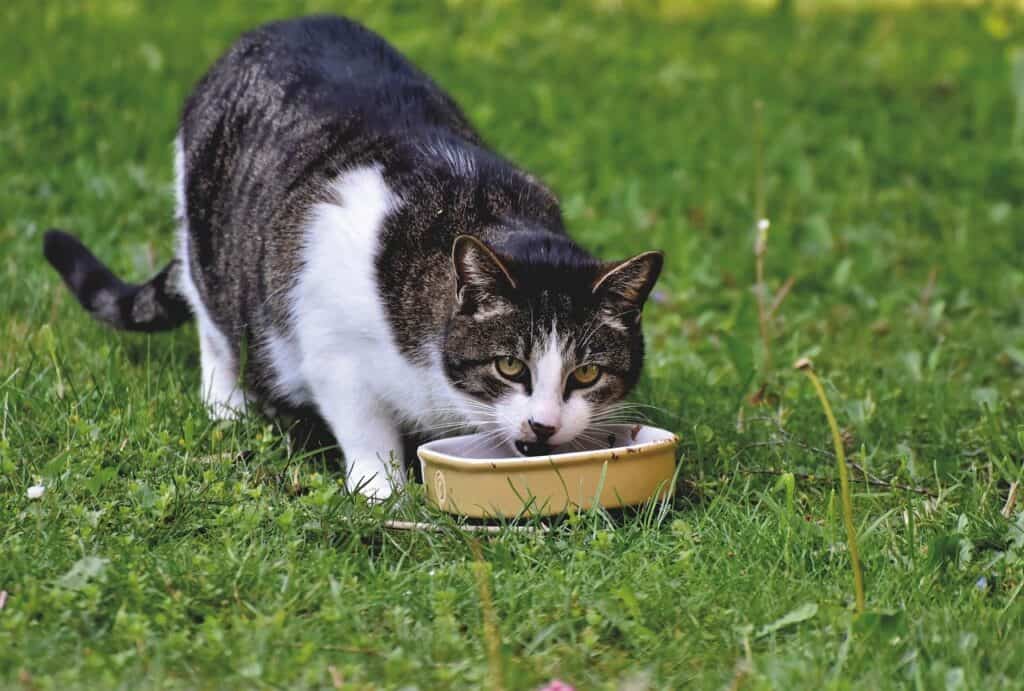Most of us humans love chocolate, and you might ask yourself if you can share your sweet treat with my cat? Before sharing your guilty pleasure with your cat, or any human food for that matter, it’s best to check whether or not your cat can eat chocolate.
Cats can’t eat chocolate because it contains theobromine and caffeine. These substances can be metabolized by humans but are toxic to cats. For cats, chocolate ingestion could lead to liver failure or even death. A cat that exhibits signs of chocolate poisoning needs acute medical attention.
All cat parents know that cats can be very, very persuasive in getting us to share our food with them. Some of us simply can’t resist those cute faces with those begging eyes, and we cave. Occasionally giving our cats a treat is perfectly fine however, certain human foods are toxic to cats. Chocolate is one of those foods
Why is chocolate toxic to cats?
Both caffeine and theobromine are so-called “feel-good” substances for humans. Especially theobromine seems to have several positive side effects for us. Theobromine is also present in tea leaves, and caffeine is a well-known component of coffee beans.
For cats, however, both ingredients are harmful to their health because their bodies cannot process these toxins to get rid of them naturally. Because of this, the toxins will accumulate in their bloodstream, causing a host of complications that could lead to liver failure, seizures, coma, cardiac arrest, and even death.
Luckily, cats are picky eaters and according to the ‘Pet Poison Helpline‘, cats getting a chocolate overdose is rare. They say that 95% of all chocolate poisoning cases concerns dogs and not cats.
What are the symptoms of chocolate poisoning?
In cats, theobromine affects the central nervous system, the cardiovascular system, and the respiratory system.
Because cats are very sensitive to the harmful components of chocolate, it will usually only take 2-4 hours for them to exhibit the symptoms of chocolate poisoning. Even after eating small amounts of chocolate, your cat will appear quite sick.
Be careful though, cats are very good at hiding weakness, and they may hide away when they’re not feeling well. If your cat is behaving differently, keep an eye on them and see if something is wrong.
The earliest signs of chocolate poisoning in cats are vomiting, and diarrhea as their body will try to eject the substance from its system. You might also notice your cat urinating more than usual as their kidneys are working overtime to get rid of the toxins in their body.
Because cats cannot process theobromine and caffeine, the symptoms will progressively worsen over the course of about 24 hours until your feline gets the medical attention that it needs.
The most common symptoms of chocolate poisoning (caused by theobromine and caffeine) in cats are:
- Vomiting
- Diarrhea
- Nausea and disorientation
- Increased heart rate
- Excessive thirst and urination
- Hyperactivity
- Increased body temperature
- Rapid breathing
- Twitching
- Low blood pressure
- Seizures
- Coma
- Muscle tremors
- Heart failure
- Kidney Failure
What to do if your cat consumed chocolate?
First of all, even though you might be worried about your feline friend, try to keep a cool head. Your cat has the best chance of recovery if you stay calm. Cats are very sensitive to mood changes, and if you panic, they will panic.
If you suspect that your cat has digested chocolate, it is essential to act fast. Cats have a better chance of survival by preventing the toxins from reaching their bloodstream.
Get medical advice. Your veterinarian will know what to do and handle in your furry friend’s best interests.
A vet will make a cat throw up (by giving it a small amount of Hydrogen Peroxide to induce vomiting) to empty its stomach and minimize the toxins getting into its bloodstream.
Time is of the essence, so contact your vet immediately and tell them your cat has eaten chocolate so that they know this is an urgent case. The vet may give you some instructions over the phone. Whatever you do, do not try to induce vomiting in your cat by yourself unless your vet gives you specific instructions to do so.
Once you get to the clinic, the vet may give your cat medicine to induce vomiting. This is to expel any chocolate that may still be in your cat’s stomach and get rid of any wrappers it may have consumed as well.
They will also perform several tests to assess the severeness of the situation and start an IV on your cat to prevent dehydration and dilute the toxins in your cat’s blood. The vet might also do an ECG to look for abnormal heart rhythms.
There is a good chance that your cat will survive its ordeal if they receive prompt medical attention.
How much chocolate is toxic for cats?
The toxic dose of theobromine in cats is 200mg/kg. This does not directly relate to a specific amount of chocolate because different types contain different amounts of cocoa. Generally speaking, the darker the chocolate, the more amounts of theobromine it contains.
| Types of chocolate | Toxic amount for a cat |
|---|---|
| Milk chocolate | 1.14 oz / 32 grams |
| Dark chocolate | 0.5 oz / 14 grams |
| Semisweet chocolate | 0.5 oz / 14 grams |
| Baking chocolate | 0.2 oz / 5.5 grams |
| White chocolate | No cacao component – non toxic |
Since the cacao used to produce the chocolate is the culprit, some chocolates are worse than others.
Dark is the most dangerous to cats because it contains the most cacao. Milk chocolate is somewhat less hazardous than the darker chocolate variants because the cacao component is much lower. Because white chocolate does not contain any cacao, it is not harmful to cats.
Either way, it is best to make sure your cat doesn’t have access to any chocolate. See a vet if your cat digested any amount of it. After all, it’s better to be safe than sorry.
How to prevent your cat from eating chocolate?
Although felines instinctively know not to eat foods that can harm them, the chances that they search for chocolate to eat are very slim. However, cats are curious creatures, and when they see us enjoying something eatable, they might be tempted to try it for themselves.
Even when you’re aware of the potential dangers of chocolate for cats, there might be a moment when no one’s looking and your cat snatches some of your delicious chocolate.
As is clear from the table above, it only takes a minimal amount to make your cat sick. Here are some best practices to minimize the chance of your cat getting their paws on any of your chocolate.
- Keep your chocolate out of sight and out of reach of your cat
- Store your chocolate in airtight containers which your cat cannot open
- Give your cat a safe treat while you are enjoying your chocolate
Alternative treats you can feed your cat
All loving cat parents are known to want to spoil or treat their cat-children every once in a while; most often, treats that are specifically made for cats are the best and the healthiest treats.
If you would like to give your cat something new and exciting instead, have a look at the treats listed below. These are safe for cats to eat. Your cat may not like all of them because, just as for humans, the taste is a personal thing.
Here are some human foods that are completely safe for cats to eat:
- Fish
- Cheese
- Berries
- Melon
- Carrots
- Peas
- Rice
- Pumpkin
- Oatmeal
- Cooked/fried eggs
- Broccoli
Although it is understandable that pet owners want to give their cat a treat every now and then, experts say it’s best to just stick to feeding your cat healthy cat food.
Can cats eat Nutella?
Because Nutella is made of chocolate, cats cannot safely consume it. Chocolate contains theobromine and caffeine, which are toxic to cats, even in small amounts. After chocolate ingestion, your cat will get sick. Depending on the amount of chocolate consumed, the effects can be severe and even lead to death.
Can cats survive eating chocolate?
When promptly treated by a vet after consuming chocolate, cats have a good chance of surviving the ordeal. The treatment will include emptying your cat’s stomach, administering fluid therapy, and possibly an ECG to monitor your cat’s heart rhythm.
Is chocolate milk dangerous for cats?
Chocolate is toxic for cats, no matter in what form they consume it. Although the amount of cacao in chocolate milk is relatively low, your cat may still be at risk. If your cat consumed any amount of chocolate, consult with a vet to determine what treatment is needed.
Can I feed my cat sweet treats?
As a general rule, you shouldn’t feed your cat sweet treats. Because cats cannot taste sweetness, it gives them no pleasure. Because cats are very susceptible to diabetes caused by irregularities in their blood sugar level, they should not digest any sugar.




